OCZ's RevoDrive Preview: An Affordable PCIe SSD
by Anand Lal Shimpi on June 25, 2010 2:15 AM ESTOverall System Performance using PCMark Vantage & SYSMark
Next up is PCMark Vantage, another system-wide performance suite. For those of you who aren’t familiar with PCMark Vantage, it ends up being the most real-world-like hard drive test I can come up with. It runs things like application launches, file searches, web browsing, contacts searching, video playback, photo editing and other completely mundane but real-world tasks. I’ve described the benchmark in great detail before but if you’d like to read up on what it does in particular, take a look at Futuremark’s whitepaper on the benchmark; it’s not perfect, but it’s good enough to be a member of a comprehensive storage benchmark suite. Any performance impacts here would most likely be reflected in the real world.
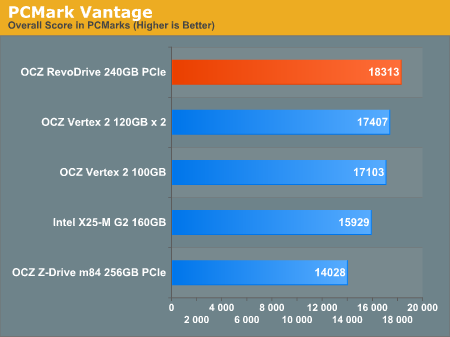
Years ago I did an article tackling the real world performance improvement by putting two hard drives in RAID-0. I argued that for most users, the performance improvement wasn’t worth the trouble. PCMark Vantage maintains that this is the case. The RevoDrive is only 7% faster than a single Vertex 2. All this tells us is that for typical desktop usage models you won’t get a huge performance boost.
The memories suite includes a test involving importing pictures into Windows Photo Gallery and editing them, a fairly benign task that easily falls into the category of being very influenced by disk performance.
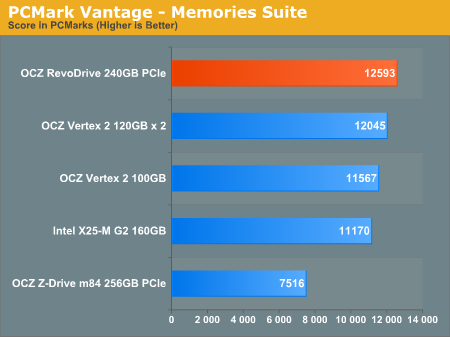
The TV and Movies tests focus on on video transcoding which is mostly CPU bound, but one of the tests involves Windows Media Center which tends to be disk bound.
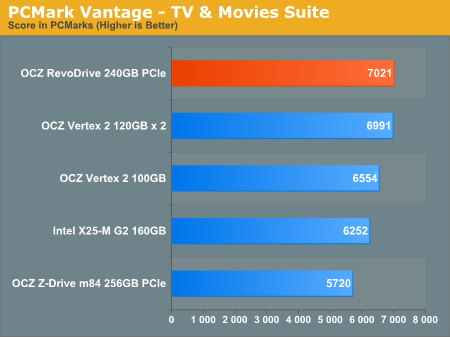
The gaming tests are very well suited to SSDs since they spend a good portion of their time focusing on reading textures and loading level data. All of the SSDs dominate here, but as you'll see later on in my gaming tests the benefits of an SSD really vary depending on the game. Take these results as a best case scenario of what can happen, not the norm.

In the Music suite the main test is a multitasking scenario: the test simulates surfing the web in IE7, transcoding an audio file and adding music to Windows Media Player (the most disk intensive portion of the test).
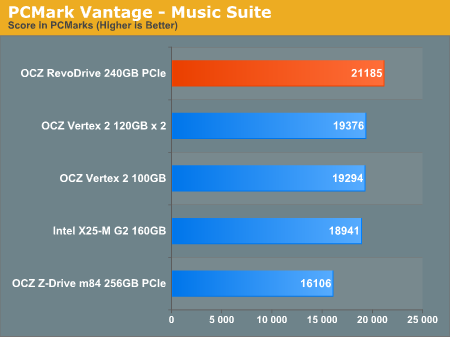
The Communications suite is made up of two tests, both involving light multitasking. The first test simulates data encryption/decryption while running message rules in Windows Mail. The second test simulates web surfing (including opening/closing tabs) in IE7, data decryption and running Windows Defender.
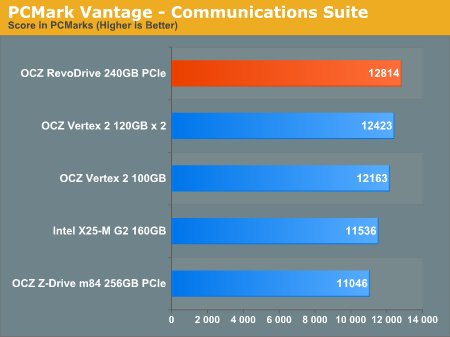
I love PCMark's Productivity test; in this test there are four tasks going on at once, searching through Windows contacts, searching through Windows Mail, browsing multiple webpages in IE7 and loading applications. This is as real world of a scenario as you get and it happens to be representative of one of the most frustrating HDD usage models - trying to do multiple things at once. There's nothing more annoying than trying to launch a simple application while you're doing other things in the background and have the load take forever.
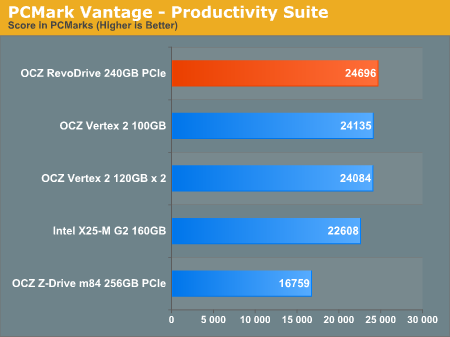
The final PCMark Vantage suite is HDD specific and this is where you'll see the biggest differences between the drives:
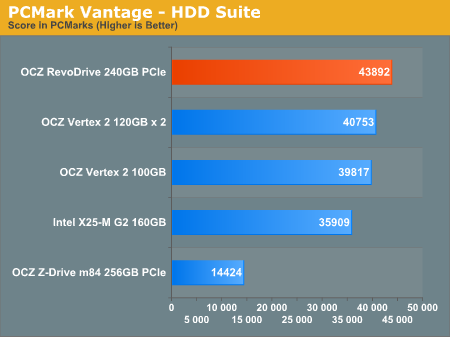
SYSMark 2007 hammers the point home as well - if you’re running more CPU bound tasks you won’t see a benefit to the RevoDrive.











62 Comments
View All Comments
shin0bi272 - Friday, June 25, 2010 - link
Please tell me you're going to give this away in your 13 year anniversary loot. I really want an SSD but Im unemployed and this one would last me a LONG time since its expandable (such a great idea btw).fwibbler - Friday, June 25, 2010 - link
Since a lot of people may be upgrading from older SSDs (like Vertex 1) it might be an idea to show one of them in a performance chart when you review the release version (in particular 2x Vertex 30GB ;-)buyaofeichu - Friday, June 25, 2010 - link
(nike-alliance).(com),Inc. We are the best online dealer,about all kinds of nike.run retailing and wholesale trade wordwidely for years. Free Shipping And Customs,Super Sale Off Retailing,With 1Week Delivery to your door.Breit - Friday, June 25, 2010 - link
wrong place pal... ;)SL_Eric - Friday, June 25, 2010 - link
Does using it on an NF200-equipped board (and the appropriate through-the-NF200 PCIe lanes) have any impact on performance?bji - Friday, June 25, 2010 - link
All this talk about upgradable flash using NAND chips on SODIMM cards inspired me to think about what the future of storage will look like.Is it likely that eventually, the SSD controllers will follow the same path that memory controllers have? Starting with external devices (which I would bet is the way that core memory was done back in the mainframe days) as we have now with external SSD controllers, then moving to controllers built into the motherboard, and finally moving to on-die controllers. All the while, with NAND flash becoming a raw commodity part that you just plug into SODIMM slots or similar on your motherboard?
So you'd buy RAM and put it in your RAM SODIMM slots, and then buy some NAND flash SODIMMS and plug those into your NAND SODIMM slots, each being handled by an on-board on on-die controller.
Is this the eventuality of solid state storage? It actually sounds really good to me. I suspect that breaking the devices apart like this, and making the SSD controllers a separate part of the system from the raw NAND flash, would allow for greater efficiency for both, and drive prices down and capacities up.
One drawback would be that the NAND flash sticks would have persisted data on them so to switch to new ones, you'd have to have somewhere to copy that data and then copy the data back onto the new sticks after you'd upgraded. Of course, that's really no different than what you have to do now when you buy a new SSD drive or (heaven forbid) spinning platter drive. The major difference being with external connector standards like SATA, you can add extra drives easily, whereas with SODIMM slots on the motherboard, you are more limited in the number of 'devices' that you can support at one time, making adding a temporary drive for the purposes of copying data around a bit harder.
allingm - Friday, June 25, 2010 - link
You know I was thinking exactly the same thing. It would be so much better if hard drive space was upgraded just like RAM. I think the RAM standard group should come up with a persistent memory storage standard.Shadowmaster625 - Monday, June 28, 2010 - link
You would just clone the SSD DIMM(s) drive image onto an external usb hard drive. Then restore the image onto the new flash DIMM(s) and, if necessary, resize the partition.nurd - Friday, June 25, 2010 - link
It seems to me that since, from the OS's standpoint, it's just a SiI 3124, if you broke the RAID and just treated it as two drives at the OS level (maybe striping them at THAT layer), you could TRIM just fine (assuming your 3124 driver supports it of course).ggathagan - Friday, June 25, 2010 - link
My guess is that you will never find TRIM support for SiL3124's.As Anand mentioned, one of the keys to the device's low cost is the use of relatively old silicon.
It would surprise me if Silicon Image was still actively doing any work on the 3124 drivers.
The latest Windows RAID drivers listed on their website are dated 2006, with a note for the 64-bit version that it supports Vista beta 2.
That part aside, TRIM support would depend on what it is about RAID that TRIM doesn't like.
Even if the controllers allows you to break up the pair to be seen as individual drives, the controller still considers each of them to be RAID0 devices.
I've no idea as to the issue between RAID and TRIM, but if the very fact that it's a RAID device disallows TRIM, then you're out of luck.
If the issue with TRIM and RAID has to do with data striping, then you might be correct, assuming that SI ever developed TRIM support for the 3124.